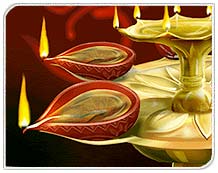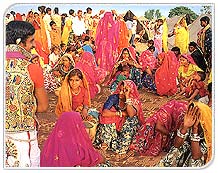Cultural India
Cultural India Home » People » History » National Anthem » National Animal » National Tree » Fairs & Festivals
Physical Features » National Emblems » National Bird » National Fruit » Religions » Languages
National Flag » National Flower » Air Line Ticketing » Map of India » Travellers Tools
---------------------------------------------------------------------------------------------------------------------------------------------------------------------------------------------------------------------------------
Fairs & Festivals
September | October | November | December
November Fairs & Festivals
 DIWALI
DIWALI
(All over India) The festival of lights is one of the most beautiful of Indian festivals. It comes 21 days after Dussehra and celebrates the return of Lord Rama to Ayodhya after his 14 year exile. Homes are decorted, sweets are distributed by everyone and thousands of lamps lit in houses all over the country making it a night of enchantment. Doorways are hung with torans(a decorative garland for the door) of mango leaves and marigolds. Rangolis (designs on floor) are drawn with different coloured powders to welcome guests. Worship of Goddess Lakshmi, the goddess of wealth, and fireworks and festivites are an essential part of the occasion.
SHARAD PURNIMA
(All over India)
Is a harvest festival when Laxmi, the Goddess of prosperity, visits all homes
to bring fortune and good luck of all. Kojagiri, the special night, is celebrated
with ice-cold, saffron-flavoured sweet milk, shared in the cool moonlight.
The full moon night is called Navanna Purnima or the moonlit night of new
food. The newly harvested rice is offered to the god s and lamps are lit before
the full moon.
GURU PURAB
(North India)
The birth anniversary of Guru Nanak- the first guru of the Sikhs who founded
the Sikh faith, is celebrated with great ferour. The 'Akhand Path' -recitation
of the Sikh holy book, Guru Granth Sahib, is held in gurdwaras all over the
country. Taking the hold book out in procession, is also an integral part
of the celebrations. Langars (community feasts) are organised where people
of all castes sit together to eat and sing hymns from the Guru Granth Sahib.
The celebrations at Amritsar are especially impressive.
KA POMBLANG NONGREM
(Meghalya)
Is the most important festival of the Khasis in Meghalaya. This five day long
festival, held annually near Shillong, is an occasion for thanksgiving for
a good harvest and the time to pray for peace and prosperity. Khasi men and
women, dressed in traditional splendour, perform the famous Nogkrem dance.
SONEPUR FAIR
(Sonepur, Bihar)
Asia's biggest cattle fair is held at Sonepur, on the banks of the River Ganga.
During this month-long fair, cattle, decorated for the occasion, swarm the
venue.

PUSHKAR FAIR
(Purhkar, Rajasthan)
Is held every year at Pushkar, near Ajmer. Thousands of pilgrims come to bathe
in the holy waters of te Pushkar Lake. Trading of cattle, camel races and
dazzling displays of bangles, brassware, clothes, camel saddles and halters
are the major attractions of this colourful event which lasts for twelve days.
HAMPI FESTIVAL
The magnificent ruined city of Hampi, once the capital of the Vijayanagar Empire, comes alive once again during this lively festival of dance and music, held in the first week of November.
Physical Features » National Emblems » National Bird » National Fruit » Religions » Languages
National Flag » National Flower » Air Line Ticketing » Map of India » Travellers Tools